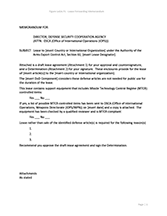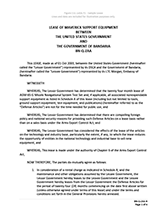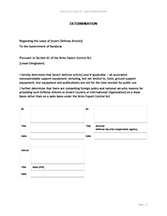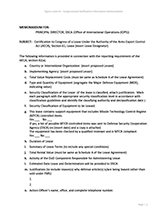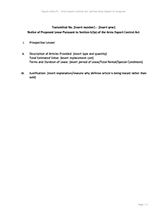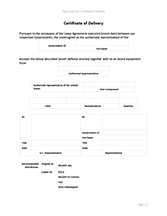Appendix 8 - Leases of Defense Articles
LoDA
SA
No
Permanent
Arms Export Control Act (AECA), Subchapter VI (22 U.S.C. 2796)
Those determined eligible in accordance with Sec. 3, Arms Export Control Act and by Presidential determination
Provides:
- Equipment
- Real Property
- Supplies
Section | Title |
|---|---|
LoDA.1. | |
LoDA.2. | |
LoDA.3. | |
LoDA.4. | |
LoDA.5. | |
LoDA.6. | |
LoDA.7. | |
LoDA.8. | |
LoDA.9. |
LoDA.1.1. Under Arms Export Control Act (AECA), section 61 (22 U.S.C. 2796), the President may lease DoD defense articles to eligible partners or international organizations for a period not to exceed 5 years plus a specified period of time required to complete major refurbishment work prior to delivery. The President has delegated this authority to the Secretary of Defense (SECDEF) who then delegated the authority to the Director of DSCA. There must be compelling foreign policy and national security reasons for providing such articles on a lease basis, and the articles must not be needed for public use at the time. Leases may provide defense articles for cooperative research and development, military exercises, or communications or electronics interface projects, to allow the USG to respond to an urgent foreign requirement. The partner is responsible for the travel, shipping and replacement cost and these costs are included in the Foreign Military Sales (FMS) support case.
LoDA.2.1. Lease Preparation and Format. Leases are prepared using the Defense Security Assistance Management System (DSAMS). Implementing Agencies (IAs) are responsible for preparing leases in accordance with the Foreign Military Sales (FMS) guidance (refer to Chapter 5). The Military Department (MILDEP) confirms the effective date, signs and forward the final lease to DSCA in the Proposed Status. The IA can make changes or updates once the lease is in “Proposed Status.”
LoDA.2.2. Lease Duration. The minimum lease period is one month. The maximum lease period is 60 months plus the specified period of time required to complete major refurbishment of the leased articles prior to delivery. The draft lease includes the initiation and finish dates and the proposed timeframe the lease should start after staffing and Congressional Notifications (CNs) are complete. The lease must include a note that the USG may terminate the lease at any time during the lease period and require the immediate return of the defense article(s). Leases of less than 60 months may be extended via an Amendment, but the total period under a specific lease may not exceed 60 months plus the time needed for major refurbishment work. Unless otherwise specified within the terms and conditions, the lease period begins on the date shown at the beginning of the lease. This does not occur if initial deposit has not been paid. If the purchaser signs the lease after the proposed starting date, the lease must be amended to show the actual lease start date and to make any necessary adjustments to the payment schedule (See Section LoDA.2.3.4. Payment Schedules).
LoDA.2.2.1. Lease Format. The lease format, including sample data and preparation instructions, is provided in Figure LoDA.F1. through Figure LoDA.F5. This format may not be altered unless special circumstances require an exception to policy as authorized by DSCA. Additional provisions may be added to a lease when appropriate and with concurrence of DSCA (Office of International Operations (IOPS)), DSCA (Office of Strategy, Plans, and Policy (SPP)), and DSCA (Front Office, Office of the General Counsel (FO/OGC)). All FMS leases are bi-lateral. A multilateral FMS lease is not permitted.
Figure LoDA.F1. - Lease Forwarding Memorandum
Figure LoDA.F2. - Sample Lease
Figure LoDA.F3. - Lease Determination
Figure LoDA.F4. - Congressional Notification Information Memorandum
Figure LoDA.F5. - Arms Export Control Act, Section 62(a) Report to Congress
LoDA.2.2.2. Lease Identification. The IA assigns a unique designator to each lease in DSAMS. The lease designator is composed of the FMS Customer Code, the IA code, and a 3-position code assigned by the IA. The lease designator is included on each lease page, all schedules, appendices, and accompanying documents included. FMS cases associated with leases must reference the lease designator(s), additionally, leases will reference the associated FMS support case.
LoDA.2.3. Lease Pricing.
LoDA.2.3.1. Rental Payment. The lessee must agree to pay in U.S. dollars all costs incurred by the USG for the leased articles, including reimbursement for depreciation of articles during the lease period. The rental payment is calculated in accordance with DoD Financial Management Regulations (DoD FMR) 7000.14-R, Volume 15, Chapter 7. Rental payments do not include an administrative charge.
LoDA.2.3.2. Exceptions. Certain leases do not require reimbursement of depreciation or may be eligible for waiver of reimbursement. DSCA must authorize the exception prior to the IAs notifying a potential lessee that a no-rent lease is available.
LoDA.2.3.2.1. Leases for the purposes of cooperative research or development, military exercises, or communications or electronics interface projects do not require reimbursement for depreciation and other costs incurred by the USG.
LoDA.2.3.2.2. The President may waive reimbursement of depreciation for any defense article(s) that has passed three-quarters of its normal service life if it is in the national security interests of the United States. This waiver authority is delegated to the DSCA Director in accordance with the provisions of DoD Directive (DoDD) 5105.65. When requesting this waiver, the IA must provide DSCA (Office of International Operations, Global Execution Directorate, Assistance & Monitoring Division (IOPS/GEX/AMD)) with the following information:
- A letter certifying that the items are beyond three-quarters (75 percent) of their service life;
- A spreadsheet showing how replacement costs were calculated, a spreadsheet showing what the depreciation charges would normally be;
- And, if applicable, a spreadsheet showing how partial depreciation charges were calculated and a copy of any prior or related waivers.
LoDA.2.3.2.3. The President may also waive reimbursement of depreciation in exchange for the lessee’s lease of defense articles to DoD on substantially reciprocal terms. In these cases, the President submits a detailed notification for each lease to the Speaker of the House, the Committee on Foreign Affairs of the House, the Committee on Armed Service of the House, the Committee on Foreign Relations of the Senate, and the Committee on Armed Services of the Senate. Unless Congress provides special authority otherwise, this waiver authority may be exercised only for the current fiscal year and only with respect to one partner.
LoDA.2.3.3. Replacement of Lost or Damaged Items. The lessee must agree to pay the costs of restoration or replacement if the articles are lost, damaged, or destroyed while leased. If items are lost or destroyed, the partner is charged the replacement cost. These costs are adjusted for either 1) the depreciated value of the destroyed item if the United States intends to replace the articles, or 2) the actual article value (depreciated value of the most recent procurement cost of the article) if the United States does not intend to replace the articles. These charges may be recouped through an amendment or modification of the annotated support case listed in the lease or through establishment of a separate Letter of Offer and Acceptance (LOA).
LoDA.2.3.4. Payment Schedules. Schedule A of each lease identifies the replacement cost(s) of the item(s) being leased and the schedule for rental payment due to the USG. The IA establishes a payment schedule on a quarterly billing cycle compatible with the FMS billing cycle. If the quarterly cycle does not provide for payment prior to the effective date of the lease, an initial deposit is required to assure that payment is received in advance of the month in which a rental charge is incurred. Billings to the partner or international organization lessee are based on this schedule of payments and are included on a separate Defense Department (DD) Form 645A with the partner’s quarterly FMS billing statement. The IA confirms that payment schedules are updated for any extensions, delivery schedule changes, or other Amendments that may result in a change to the lease value or schedule of payments. Defense Finance and Accounting Services (DFAS) deposits receipts from lease rental payments into the Miscellaneous Receipts Account 3041 (FMS Recoveries, DoD Lease Costs) in accordance with the Treasury Financial Manual, Supplement to Volume 1.
LoDA.2.4. Use of Foreign Military Financing or Military Assistance Program Merger Funds. When authorized by DSCA (Office of Business Operations (OBO)) and DSCA (IOPS), Foreign Military Financing (FMF) or Military Assistance Program (MAP) Merger funds may be used to fund LOAs for services associated with a lease. However, the Arms Export Control Act (AECA) does not allow the use of these funds for rental payments for leases made pursuant to AECA, section 61 (22 U.S.C. 2796), except for leases of aircraft for counter-narcotics purposes pursuant to Foreign Assistance Act (FAA), section 484 (22 U.S.C. 2291c). In such instances, the total lease cost (including any renewals) is an initial, one-time payment of an amount equivalent to the aircraft price as if it were sold on an LOA. Refer questions regarding proper sources of funding for leases should be directed to DSCA (OBO).
LoDA.2.5. Who Can Lease Defense Articles? Defense articles may be leased to a partner or international organization if that partner or organization is eligible for FMS purchases. See Table C4.T2A. for a list of eligible partners and organizations.
LoDA.2.6. What Can Be Leased. The President may lease defense articles from DoD stock to eligible partners or international organizations if there are compelling foreign policy and national security reasons for providing such articles on a lease basis rather than as a sale; the articles are not needed for the time for public use; and the effects of the lease on the national technology and industrial base are considered, particularly the extent, if any, to which the lease reduces the opportunity of U.S. manufacturers to sell new equipment to the lessee.
LoDA.2.6.1. Naval Vessel Leases. Naval vessel leases are subject to additional requirements contained in 10 U.S.C. 8677, which requires specific statutory authorization for the lease of naval vessels in excess of 3000 tons or less than 20 years of age, and CN for other naval vessels. AECA, Subchapter VI requirements also apply to naval vessel leases unless the separate legislation expressly provides otherwise.
LoDA.2.6.2. Counternarcotics Aircraft. The FAA, section 484 (22 U.S.C. 2291c), requires aircraft made available to a partner primarily for counternarcotics-related purposes will be provided on a lease or loan basis, rather than by sale or grant, unless to do so is determined contrary to the national interest and Congress is so notified. The FAA further requires that if FMF is used to finance the leasing of aircraft, the entire cost of any such lease (including any renewals) will be an initial, onetime payment of the amount which would be the sales price for the aircraft if they were sold via FMS.
LoDA.3.1. Partner or International Organization. The partner identifies the need and submits the written Letter of Request (LOR) for the item intended for lease.
LoDA.3.2. Implementing Agency. The Implementing Agency (IA) receives the request and determines if the request is viable. Once viability is confirmed, the IA enters the request in Defense Security Assistance Management System (DSAMS) and submits the lease package to DSCA.
LoDA.3.3. Defense Security Cooperation Agency. DSCA (Office of International Operations, Global Execution Directorate, Assistance & Monitoring Division (IOPS/GEX/AMD)) receives the lease package and completes internal and external coordination.
LoDA.3.4. Office of the Under Secretary of Defense for Policy. The Office of the Under Secretary of Defense for Policy (OUSD(P)) coordinates on the proposed lease package and verifies the proposed lease aligns with international security strategy and policy to support national security objectives.
LoDA.3.5. Department of State, Bureau of Political-Military Affairs, Office of Regional Security and Arms Transfers. Department of State, Bureau of Political-Military Affairs, Office of Regional Security and Arms Transfers (State (PM/RSAT)) reviews the proposed lease to confirm the requesting partner standing and that the proposed supports international security strategy and policy to support national security objectives.
LoDA.3.6. Department of Commerce. The Department of Commerce (DOC) Office of Strategic Industries and Economic Security reviews proposed leases to determine if the proposed lease will have adverse impact on the national technology and industrial base or will reduce the opportunities of entities in the national technology and industrial base to sell new or used equipment.
LoDA.4.1. Table LoDA.T1. summarizes the lease process.
LoDA.5.1. Congress must be given a 30-calendar day advance notification for any lease for a period of one year or longer. Like Foreign Military Sales (FMS), the Presidential decision authority to lease is delegated to the Department of State (State), with DSCA providing the subsequent Congressional Notifications (CNs). Further, if the lease is for one year or longer, and is valued at $14 million or more for Major Defense Equipment (MDE), or $50 million or more for other defense articles, the Congress may adopt a joint resolution during the 30-calendar day notification period prohibiting the proposed lease.
LoDA.5.2. For entering into or renewing a lease agreement for a period of one year or longer, the Arms Export Control Act (AECA), section 62(a) (22 U.S.C. 2796(a)) provides requirements for the President. The President provides written certification to the Speaker of the House of Representatives, the Chairman of the Committee on Foreign Relations of the House, the Chairman of the Committee on Armed Services of the House, the Chairman of the Committee on Foreign Relations of the Senate, and the Chairman of the Committee on Armed Services of the Senate. The AECA Section 62(c) (22 U.S.C. 2796(c)) provides timelines of not less than 15 calendar days before agreements with North Atlantic Treaty Organization (NATO), NATO member partners, Australia, Japan, the Republic of Korea, Israel, or New Zealand, and not less than 30-calendar days before agreements with all other partners or organizations.
LoDA.5.2.1. The certification includes the partner or international organization to which the defense article is to be leased; the type, quantity, and value (in terms of replacement cost) of the defense article to be leased; the terms and duration of the lease; and the justification for the lease, including an explanation of why the defense article is being leased rather than sold. AECA, section 62(b) (22 U.S.C. 2796(b)) authorizes waiver of the CN for leases if the President states in his or her certification that an emergency exists that requires the lease be entered into immediately in the interest of U.S. national security.
LoDA.5.2.2. The certification must include a detailed justification with a description of the emergency circumstances and a discussion of the national security interests involved. This authority is reserved to the President and has not been delegated to the Secretary of Defense (SECDEF). In the event of such an emergency, DSCA (Office of International Operations (IOPS)) provides instructions to the Implementing Agency (IA).
LoDA.5.3. Waiver; Determination of Emergency. The President may waive the requirements of AECA, section 62(a) (22 U.S.C. 2796(a)) (and in the case of an agreement described in section 2796b, may waive the provisions of that section) if the certification statement confirms an emergency in the national security interests of the United States exists and requires the immediate initiation of a lease. If the President states in the certification such an emergency exists, the certification will provide a detailed justification for the determination, to include a description of the emergency circumstances which necessitate that the lease be entered into immediately and a discussion of the national security interests involved.
LoDA.5.4. Transmission of Certification. The certification required by subsection (a) of AECA, section 62(a) (22 U.S.C. 2796(a)) must be transmitted to the partner 15 calendar days before the agreement is entered into or renewed if the agreement is with NATO, any member partner of that Organization, or Australia, Japan, the Republic of Korea, Israel, or New Zealand. For an agreement with any other organization or partner, the certification must be transmitted within 30 calendar days before the agreement start or renewal.
LoDA.6.1. Lease Process. Table LoDA.T1. summarizes the lease process.
Table LoDA.T1. Lease Process
Step | Action |
|---|---|
1 | An eligible partner or international organization identifies a requirement and submits a Letter of Request (LOR) to the respective Implementing Agency (IA) with a courtesy copy to DSCA (Office of International Operations (IOPS)). |
2 | The IA determines whether a lease is a viable option and whether the items are needed for public use during the proposed lease period. DSCA (IOPS) should be consulted at this time. With DSCA (IOPS) approval, the IA responds to the partner/organization stating whether the equipment is available and whether a lease is an available option. No actual offer may be made until the appropriate approvals/notifications are complete. If the IA recommends application of an exception to a customer’s reimbursing depreciation costs, the IA must provide justification and receive authorization from DSCA (IOPS) before advising the customer of the exception. |
3 | The IA prepares lease documents in Defense Security Assistance Management System (DSAMS) in accordance with Figures LoDA.F1. through LoDA.F5. The lease package consists of: the lease agreement with all terms/conditions and payment schedule (Schedule A see Section LoDA.2.3.4.), the determination of compelling foreign policy and national security interests, the determination that the articles are not needed for public use during the proposed timeframe, a statement as to why a lease is preferable to a sale, a forwarding memorandum, and a draft Congressional Notification (CN) if the duration of the proposed lease exceeds one year. The cost for the travel, shipping and replacement cost is the responsibility of the partner and is accounted for in the support Foreign Military Sales (FMS) case. |
4 | The IA coordinates the lease package internally. The IA must screen all lease items for articles controlled under the Missile Technology Control Regime (MTCR). See Chapter 3. After the IA has reviewed and coordinated on the lease package, it enters the “MILSGN” milestone into DSAMS. This milestone changes the lease status to “Proposed.” |
5 | For leases that are less than one year in duration, the IA submits the lease determination and forwarding cover memorandum to DSCA (IOPS) electronically for countersignature. For leases that are one year or longer in duration, the IA submits the lease, determination, CN certification, and forwarding cover memorandum to DSCA (IOPS) electronically for countersignature. If not submitted electronically, IAs may submit lease packages for countersignature to: Lease Program Manager (DSCA (Office of International Operations, Global Execution Directorate, Assistance & Monitoring Division (IOPS/GEX/AMD)) |
6 | DSCA (IOPS) coordinates the lease package within DSCA and with Office of the Under Secretary of Defense for Policy (OUSD (P)) (Regional Offices) and the State. If the lease is for less than one year in duration, go to Step #8. |
7 | DSCA (IOPS) prepares the CN required by Arms Export Control Act (AECA), section 62(a) (22 U.S.C. 2796(a)). All documents are coordinated with OUSD (P) (Regional Offices), State, and DSCA before the DSCA Director signs the notifications. If a lease requires a CN, an advance draft copy of the unsigned lease may be provided to the customer when the CN has been delivered to Congress. |
8 | Upon completion of coordination, and the CN period if required, DSCA (IOPS) submits the lease determination to the DSCA Director for signature. After signature, DSCA enters the “DCSGN” milestone in DSAMS. This milestone automatically sets the lease status to “Offered,” and posts “DSCA Approved” and the date of the “DCSGN” milestone in the countersignature block. DSCA provides a copy of the signed Determination to the IA. |
9 | Upon receipt of the “DCSGN” milestone, the IA signs the lease document and sends it to the partner for review and signature. |
10 | The partner signs the lease and sends any required initial deposit to the Defense Finance and Accounting Services - Indianapolis (DFAS-IN). If the purchaser signs the lease after the proposed starting date, the lease must be amended to show the actual lease start date and any payment adjustments necessary on the Schedule A. |
11 | The IA confirms that DFAS-IN has received the initial deposit, if required. After receipt of the deposit the lease is implemented. DFAS-IN receives DSAMS Management Flags when a lease moves to “Offered” status and “Implemented” status. |
12 | The IA or DSCA (IOPS) may require a certificate of delivery (See Figure LoDA.F6.) when a leased item(s) is provided to the lessee. The IA is responsible for tracking and monitoring the lease to ensure conditions of the lease agreement are followed. These responsibilities include, but are not limited to:
DFAS-IN is responsible for collecting rental payments and delivery reporting. |
13 | The IA will enter the delivery and equipment return dates in DSAMS. The IA is responsible to monitor, amend and close the lease in DSAMS and follow up with DFAS-IN to ensure the financial closure. When all required data has been entered, DSAMS automatically notifies DFAS-IN that the lease is ready for closure. DFAS-IN in coordination with the DSCA Country Finance Director (CFD) will reconcile the financial information and close the lease in Defense Integrated Financial System (DIFS). The same case closure procedures for a Letter of Offer and Acceptance (LOA) (see Chapter 16) are required for case closure for a lease in DSAMS. |
Figure LoDA.F6. - Certificate of Delivery
LoDA.7.1. Written Certification to the Speaker of the House and Chairmen of Congressional Committees. The President will transmit a written certification to the Speaker of the House of Representatives, the chairman of the Committee on Foreign Relations of the Senate, and the chairman of the Committee on Armed Services of the Senate before entering into or renewing any agreement with a partner or international organization to lease any defense article under this subchapter, or to loan any defense article under chapter 2 of part II of the Foreign Assistance Act (FAA) of 1961 (22 U.S.C. 2311), for a period of one year or longer. The certification specifies:
- The partner or international organization to which the defense article is to be leased or loaned;
- The type, quantity, and value (in terms of replacement cost) of the defense article to be leased or loaned;
- The terms and duration of the lease or loan; and
- A justification for the lease or loan, including an explanation of why the defense article is being leased or loaned rather than sold under this chapter.
LoDA.7.2. Foreign Military Training Report. All training conducted under the Lease authority is subject to inclusion in the annual Foreign Military Training Report (FMTR). See Section C10.21.2. for more information.
Leases Legislation and Authorities
Legislation | Subject |
|---|---|
Arms Export Control Act (AECA), Subchapter VI (22 U.S.C. 2796) | Lease authority, limitations, and terms. |
AECA, Section 62 (22 U.S.C. 2796a) | Congressional Notification (CN). |
AECA, Section 62(a) (22 U.S.C. 2796(a)) | Legislative Review. |
Foreign Assistance Act (FAA), Section 484 (22 U.S.C. 2291c) | Aircraft made available to a partner primarily for narcotics-related purposes will be provided on a lease or loan basis, rather by sale or grant, unless to do so is determined contrary to the national interest and Congress is so notified. |
Unique requirements regarding ship leases. |
LoDA.9.1. N/A

